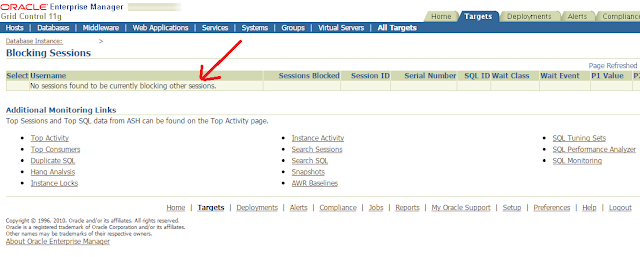We can use Oracle Enterprise Manager (OEM) grid control to identify and resolve locking situations. We can find all current locks in the instance, including the blocking and the blocked sessions. We can also kill the blocking session from OEM Grid control.
We can view blocking session details by clicking the Performance tab in the Home page. Click Blocking Sessions under the Additional Monitoring Links section to go to the Blocking Sessions page. The Blocking Sessions page contains details for both the blocking as well as the blocked sessions. We can see the exact wait event, which will be enq: TX row lock contention when one session blocks another. We can find out the exact SQL statement that’s involved in blocking sessions, by clicking the SQL ID link on this page. We can kill the blocking session from this page by clicking the Kill Session button at the top left side of the page.
In the Additional Monitoring Links section is another link named Instance Locks, which takes us to the Instance Locks page. The Instance Locks page shows the session details for both the blocking and blocked sessions. We can click the SQL ID link to view the current SQL that’s being executed by the blocker and the blocked sessions. We can also find out the name of the object that’s locked. You can kill the blocking session by clicking the Kill Session button.
We can view blocking session details by clicking the Performance tab in the Home page. Click Blocking Sessions under the Additional Monitoring Links section to go to the Blocking Sessions page. The Blocking Sessions page contains details for both the blocking as well as the blocked sessions. We can see the exact wait event, which will be enq: TX row lock contention when one session blocks another. We can find out the exact SQL statement that’s involved in blocking sessions, by clicking the SQL ID link on this page. We can kill the blocking session from this page by clicking the Kill Session button at the top left side of the page.
In the Additional Monitoring Links section is another link named Instance Locks, which takes us to the Instance Locks page. The Instance Locks page shows the session details for both the blocking and blocked sessions. We can click the SQL ID link to view the current SQL that’s being executed by the blocker and the blocked sessions. We can also find out the name of the object that’s locked. You can kill the blocking session by clicking the Kill Session button.






thanks
ReplyDeleteWelldone Riyaz Bhai ... Good Job in your Blog !! keep it bro
ReplyDeleteLove u !